Art Deco decor – 10 expert ways to introduce this decadent design trend
Capture the iconic style of the 1920s with our guide to perfect Art Deco decor in your home


Welcome to the year of Art Deco decor, our modern take on the pure drama, energy and optimism of all things Art Deco. Think rounded and smooth corners, the clean-cut lines, the geometric patterns, the glass, the velvet… but with an edginess that’s here to stay.
Here we explore the very best of the Art Deco décor trend – and how to effectively and beautifully use this popular interior design aesthetic in your home.
Art Deco decor ideas – how to embrace this popular trend
The age of jazz, roaring cars, glamorous décor and romantic train travel, cocktails in slender glasses, swinging ropes of pearls, beads and bobbed hair, feather boas and fringes, optimism and energy, color and noise – forget 2020, let us take you back to the early 1920s.
These decorating ideas will inspire you to recreate the timeless Art Deco interior design trend in your home – in 10 simple yet stylish ways.
1. Create a layered look with glamorous touches

This apartment lies in the iconic Battersea Power Station in London, so a lot of the design influences were inspired by the Art Deco heritage of the building. 'I opted to divide the large living space into three distinctive functions, starting with the dining space pictured,' says interior designer, Natalia Miyar. 'The entire room is papered in a champagne-colored linen with a woven finish that gives it softness and warmth.'
'We looked at Art Deco rugs by Francis Bacon and came up with this design which is my favorite piece, she adds. 'It references his style but with a more linear interpretation. I like to create contrasts within the palette so we introduced petrol blues, black and gold.'
'Nothing beats an upholstered chair for long, relaxed dinners. This design was inspired by a 1930s piece. I love the contrast of the angular chairs and curvy dining table, which again takes its inspiration from the Art Deco era with a finish that resembles parchment.'
The displays of art and objets bring character and visual interest to the space. The designer picked up vintage pieces and juxtaposed them with contemporary works, including a bowl by Irish glassblower Edmond Byrne and an engraving by Cuban artist Guido Llinás.
2. Add glamor with fluted details

Now found on glass, basins, backsplashes and kitchen cabinet ideas, the ribbed surfaces of the Art Deco era are making waves in art deco kitchen ideas.
For fluting on a grand scale, look to Smallbone’s Icarus Collection for inspiration. Demonstrating the impact of outsized sculpting in the kitchen, this unique design nods to 1920s glamor via scalloped glass, rich textures and warm tones. A shimmering wash of brushed gold accentuates the curved oak cabinet fronts, while allowing subtle graining to shine through.
‘The unique curve was achieved using materials technology typically used in the protection zones for cars in F1 motor racing to reinforce and lighten the doors,’ says Smallbone’s ideation director, Iain O’Mahony. ‘The aim was to capture a sense of boundless imagination and craft-led design.
3. Take inspiration from the terrazzo trend

Give your bathroom an instant update with this stylish surface that adds dynamism in spades. Terrazzo comes in many forms, but the main types of authentic terrazzo are cement or resin based.
For this Art Deco bathroom in The Siren Hotel, Detroit, design development firm ASH NYC cleverly combined both types of terrazzo according to use. The bathroom flooring is a cementitious terrazzo, which feels soft underfoot and is extremely durable but requires annual resealing. The chequerboard installation is a smart visual technique for diluting terrazzo’s bold impact. The eye-catching basin is resin-based terrazzo, which comes in bright colors and has a smoother, hygienic finish that’s easy to clean and less prone to cracks than cement-based terrazzo, with no sealing required.
4. Be inspired by a vintage pink color scheme

'I enjoy using pink in its many forms, dull, blush and even an orange-y pink,’ says Charu Gandhi, director of Elicyon. 'Our projects are often quite tailored and chic so we find pink is very adaptable and fits well, it can be striking but also romantic and gives a real sense of soft glamor – almost a romanticism. Pink room ideas also work very well with metals and even champagne gold trim fabrics, a common element within Art Deco decor ideas.'
Most colors go with pink but if you want to create a sophisticated look, stick to decorating with pink and natural shades, especially earthier tones, such as warm brown and cinnamon. Other colors that go with pink and look elegant include black, dark blue, deep green and orange.
5. Revisit time-worn designs

Reclaimed wood has clear environmental benefits, not to mention unique historic appeal. Often associated with very rustic, time-worn designs, this version by salvage specialists Retrouvius demonstrates a more sophisticated approach. Made from old timber shelving, the geometric door fronts are beautifully executed for maximum impact.
‘Our salvaged tropical hardwoods were used in the areas where the main cooking action takes place,’ says Maria Speake, founder, Retrouvius. ‘Brilliant for the backsplash and kitchen countertops, the wood is innately water-resistant, hard-wearing and the odd splash of oil from cooking all adds to the timber’s own natural oiliness and is absorbed to help protect the wood.’
6. Up the glamor with plush velvet

Art Deco works are often symmetrical, geometric, streamlined and pleasing to the eye. This style is in contrast to avant-garde art of the period, which challenged everyday designers to find beauty in what were often anti-traditional forms.
Welcome bygone-era glamor into your home with beautiful materials. Luxurious and eclectic, velvet gives furnishings a deluxe update this season. In a sultry palette of jewel tones, these dramatic looks have a rich, heritage-meets-fashion attitude. Soften hard architecture by lavishing touches of pomegranate, midnight teal and emerald forest with humble, natural textures like exposed wood. Channelling Art Deco grandeur, this is all about juxtaposing opulence with an honest foundation.
7. Play with scale

Large bedroom ideas can be challenging, as furniture tends to get lost in big spaces. The key is to have just a few well-proportioned pieces, not multiple furnishings, which can look disparate and underwhelming.
Here, interior designer Rebecca Hughes has used a softly patterned wallpaper idea to draw the walls in. The extra-wide bed and corresponding ottoman help to fill out the space, while a pair of large-scale matching artworks harnesses the scheme. 'Opt for three or four statement pieces, says Rebecca, 'using symmetry to add a little grandeur and subtle pattern for depth.'
In this classically designed room with Art Deco elements, strong lines have been used to add definition: from the dark wood-framed chests and studded ottoman to the blinds with contrasting trim. Overscaled artwork cements the look.
8. Introduce decorative paneling

Sometimes all you need is the very hint at a partition to visually zone off one space from another. Use decorative glazing carefully and you may find you only need to extend this a foot or so into the center of a room to break the open-plan kitchen flow enough to create the desired separation.
This project from design firm Maddux Creative uses a steel frame with geometric glazed panels. Nodding at Art Deco design, the panels have been filled in with a variety of glazing techniques, from colored to fluted glass. Continue the feeling of stepping into a new space by adapting the flooring accordingly, too. Here, the floor tiles reflect the tones and geometrics of the panel, emphasizing its importance in the scheme.
9. Invest in a standout home bar

The decadence and glamor of the 1920s is back in a big way, and you can apply this mood anywhere in your home.
A generous home bar is now the epicentre for modern home life and a hub for entertaining, so this interior designers believe this to be the optimum space to go for all-out opulence on a grand scale.
‘This return to grandeur is refined and luxurious yet comfortable and allows for mixing different period pieces while connecting the schemes through unified color palettes,’ explains Marisa Gutmacher, executive design director at Samuel & Sons.
10. Go for a dynamic combination

Zsa Zsa wallpaper in Bottle Green, Divine Savages
To treat a bathroom as purely functional is to miss out on the opportunity to explore noble materials and eloquent furnishings inspired by the Art Deco period.
As a smaller room, the powder room is ripe for embracing wallpaper in Art Deco patterns and prints. ‘People worry about durability and practicality but, with a little care, there’s nothing to fear,’ assures Jamie Watkins, co-founder, Divine Savages. ‘We recommend utilizing tiling or painted paneling in areas prone to splashing. Paneling the lower half of the wall and then wallpapering above is a particularly sophisticated look.’
'I love pattern layered on pattern,' says Dara Caponigro, creative director, Schumacher. 'The trick is to use different scales – something large, medium and small with a common color thread – even if it’s just a small note of the same color carried through. Every single one of my walls is papered with a pattern. It creates a wonderful jewel box of sorts and has great emotional impact – so much better than boring white walls.
What defines the Art Deco style?
Art Deco style is defined by the glamor and opulence of the early 1920s. With the advent of large-scale manufacturing, interior designers and architects wished to enhance the appearance of mass-produced functional objects.
Art Deco is often defined as the pursuit of beauty. It was directly reflective of the mass usage of machine-age technology rather than handcrafted methods. Unsurprisingly, the Art Deco ethos diverged from the Art Nouveau style, which further emphasized the uniqueness of handmade objects and featured stylized forms.
How did the Art Deco trend start?
Trends have been with us for a long time. Sometimes a single event can unleash a trend. The 1925 Paris world’s fair, Exposition Internationale des Arts Décoratifs et Industriels Modernes, is credited with launching Art Deco style.
Sign up to the Homes & Gardens newsletter
Design expertise in your inbox – from inspiring decorating ideas and beautiful celebrity homes to practical gardening advice and shopping round-ups.

Jennifer is the Digital Editor at Homes & Gardens. Having worked in the interiors industry for several years in both the US and UK, spanning many publications, she now hones her digital prowess on the 'best interiors website' in the world. Multi-skilled, Jennifer has worked in PR and marketing and occasionally dabbles in the social media, commercial, and the e-commerce space. Over the years, she has written about every area of the home, from compiling houses designed by some of the best interior designers in the world to sourcing celebrity homes, reviewing appliances, and even writing a few news stories or two.
-
 I'm 5ft2 and this telescopic scrubber safely and easily banished mold and grime in even the hardest-to-reach areas of my bathroom in less than 15 minutes
I'm 5ft2 and this telescopic scrubber safely and easily banished mold and grime in even the hardest-to-reach areas of my bathroom in less than 15 minutesMy bathroom has never looked better thanks to this handy $16 two-in-one tool from Joseph Joseph
By Ottilie Blackhall Published
-
 Everyone is obsessed with vintage tiles right now – bring the nostalgic charm of this classic design feature into your home with our 5 design ideas
Everyone is obsessed with vintage tiles right now – bring the nostalgic charm of this classic design feature into your home with our 5 design ideasHonor the past with our favorite ways to decorate with vintage tiles, as suggested by interior design experts
By Eleanor Richardson Published